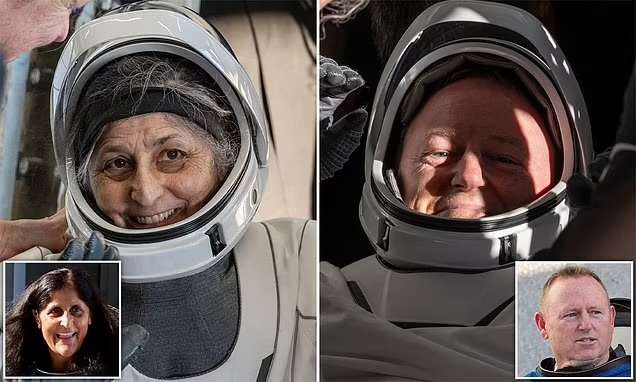NASA’s Stranded Astronauts Return to Earth—But at What Cost?
After nine grueling months in space, NASA’s stranded astronauts, Butch Wilmore and Suni Williams, have finally returned to Earth.
But experts warn that their unexpected extended stay on the International Space Station (ISS) could have lasting health consequences.
Shocking Transformation: The Toll of Nine Months in Space
Before-and-after images reveal the alarming physical changes caused by prolonged exposure to space. From “chicken legs” and “baby feet” to an increased risk of cancer, the duo may face years of recovery.
As the 59-year-old Williams and 62-year-old Wilmore emerged from their SpaceX Crew Dragon capsule, medical teams rushed to help them onto stretchers—a standard procedure for astronauts whose muscles weaken after months in microgravity.
Now back at NASA’s Johnson Space Center in Houston, they are undergoing intensive medical checks. However, experts had already raised concerns about their gaunt appearance and apparent weight loss while they were still on the ISS.
BEFORE:
• Suni Williams left Earth nine months ago on what was supposed to be an eight-day trip.
• Butch Wilmore was in robust health before his mission.
AFTER:
• Wilmore was unable to walk after landing and had to be carried onto a stretcher.
• Williams appeared frail, with experts raising concerns about her dramatic weight loss.
The Hidden Dangers of Space: Vision Loss, Cognitive Decline, and More
Beyond their physical changes, both astronauts face potential long-term health issues.
1. Vision Loss and Brain Pressure
Microgravity causes fluids to shift toward the head, increasing pressure on the eyes and optic nerves. This can lead to Spaceflight-Associated Neuro-Ocular Syndrome (SANS)—a condition that causes blurry vision in about 70% of astronauts.
NASA warns that some effects of SANS may be permanent, and the longer astronauts stay in space, the greater the risk of lasting vision damage.
2. Cognitive Decline and Mental Fog
Studies have shown that astronauts in space process tasks significantly slower and experience weakened memory and attention. Some even show altered risk-taking behavior.
While there’s no conclusive evidence that these changes persist after returning to Earth, nine months in space is uncharted territory.
BEFORE:
• Williams and Wilmore were sharp and alert before the mission.
AFTER:
• NASA experts monitored them for signs of slowed reasoning and weakened memory.
Muscle and Bone Loss: The Struggle to Stand Again
One of the biggest risks of long-term space travel is muscle and bone deterioration. Without gravity, the body stops working as hard to support itself, leading to rapid muscle atrophy.
Astronauts exercise two hours per day on the ISS, but even that isn’t enough to fully counteract the effects of weightlessness.
Dr. Vinay Gupta, a pulmonologist and Air Force veteran, warns that the astronauts could need up to six weeks of rehabilitation to regain their strength—including guided exercise and a strict nutritional plan.
BEFORE:
• Wilmore, standing at six feet tall, weighed over 210 pounds.
AFTER:
• His gaunt face and frail appearance raised concerns that he had lost too much weight.
The Silent Killer: Space Radiation Exposure
Radiation exposure is one of the greatest threats to astronaut health.
In just one week on the ISS, astronauts receive the same amount of radiation exposure as an entire year on Earth.
Unlike Earth’s protective atmosphere, space is filled with dangerous cosmic radiation that can penetrate the body, causing DNA damage and increasing the risk of:
• Cancer
• Central nervous system damage
• Bone loss
• Cardiovascular diseases
Dr. Gupta warns that given their exceptionally long exposure, both astronauts may need enhanced cancer screenings for years to come.
BEFORE:
• Wilmore was protected from cosmic radiation on Earth.
AFTER:
• He and Williams now face an increased risk of radiation-related illnesses.
Puffy Faces and Shrunken Legs: The Strange Effects of Microgravity
Microgravity doesn’t just affect muscles and bones—it reshapes the body itself.
• Fluids shift upwards, causing “puffy face syndrome.”
• Legs appear unusually thin and weak, nicknamed “chicken legs.”
• Astronauts can lose up to 10% of their bone density, making fractures more likely.
Though many of these changes reverse after weeks or months on Earth, some astronauts never fully regain their bone density.
The Long Road to Recovery
NASA has a rigorous 45-day rehabilitation program to help astronauts rebuild their strength, including:
Phase 1:
• Gait training: Retraining the body to walk under gravity.
• Obstacle navigation: Improving balance and coordination.
Phase 2:
• Cardio reconditioning: Running on treadmills and cycling to restore endurance.
• Proprioceptive training: Strengthening mind-body coordination.
Phase 3:
• Functional development training: High-intensity workouts to return astronauts to peak condition.
Most astronauts recover within 45 days, but some take months or even years.
Final Thoughts: The Cost of Space Exploration
While Wilmore and Williams are now safely back on Earth, their health challenges are far from over.
Their harrowing experience raises serious questions: How can NASA better protect astronauts on long-duration missions? And what does this mean for future missions to Mars, which could last years?
For now, all eyes are on NASA’s rehabilitation efforts—and whether these astronauts will ever fully recover from their time in space.

















